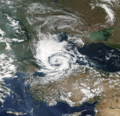User:RandomInfinity17
Hello! I track tropical and subtropical cyclones around the world.
| This user participates in WikiProject Tropical cyclones. |
| This user participates in the Non-tropical storms task force. |
| This user likes tracking tropical cyclones. |
| This user is really fascinated by the weather. |
| This user is interested in severe weather. |
| This user is a participant in WikiProject Weather |
| This user's most intense tropical cyclone ever experienced was Hurricane Marie in 2014. |
Interesting weather and space images[edit]
-
A possible subtropical cyclone in the Black Sea on September 27, 2005.
-
Radar scan of the 2021 Western Kentucky tornado lifting debris from the town of Mayfield 30,000 feet into the atmosphere.
-
Storm Dennis, the most intense European windstorm of the 21st century, on February 15, 2020.
-
Track of Tropical Storm Five of the 1952 Atlantic hurricane season, the northernmost forming Atlantic tropical cyclone.
-
A house that was wiped off its foundation after the extremely violent 2011 Hackleburg–Phil Campbell tornado.
-
Subtropical Cyclone Katie near Easter Island on May 2, 2015.
-
One of the first photos of the Andromeda Galaxy, taken in 1899 by Issac Roberts.
-
Image of the 1997 Jarrell tornado at peak intensity over the Double Creek Estates in Jarrell, Texas.
-
Satellite image of the 2022 Hunga Tonga–Hunga Haʻapai eruption and the extratropical remnants of Cyclone Cody.
-
Radar loop of the most prolific December tornado outbreak on record on December 15, 2021.
-
Cryovolcanoes spewing out ice at the south pole of Enceladus.
-
Hurricane Dorian approaching Canada as powerful extratropical cyclone on September 7, 2019.
-
An unrated landspout tornado near Marble, Colorado on May 29, 2021.
-
A record-breaking bomb cyclone off the coast of the Pacific Northwest on October 24, 2021.
-
Subtropical Storm One at peak intensity on January 16, 2023.
-
C/2022 E3 (ZTF), a long-period comet, on January 27, 2023.
-
A waterspout inside of Tropical Storm Colin on June 6, 2016.
-
Track of Cyclone Freddy, the longest-lived tropical cyclone on record.
-
A potential subtropical storm of the coast of Morroco on February 17, 2002.
-
The 1904, Moscow tornado, one of the deadliest Russian tornadoes on record.
-
2023 CX1 entering Earth's atmosphere over France on February 13, 2023.
-
Subtropical Storm Raoni off the coast of Argentina on June 28, 2021
Tropical cyclones in 2023 (personal analysis)[edit]

Subpages[edit]
My Subpages:
Good ones/Actively working on[edit]
- My sandbox
- Effects of the 1982–83 El Niño in Peru†
- Tropical Storm Namtheun (2021)†
- Unusual areas of tropical cyclogensis†
- Potential Tropical Cyclone Four†
- F6
- 2023 Naypyidaw tornado†
- List of costliest tropical cyclones
Inactive[edit]
- Significant tornadoes of 2023
- Table of Central Pacific tropical cyclones†
- Deadliest tropical cyclones by basin
Mainspace[edit]
- List of costliest tropical cyclones
- Template:Table of F5 and EF5 tornadoes
- Weather of 1985
- October 2022 Southern Ocean cyclone
† open to editing from others
My best works[edit]
- Weather of 2023 (
 / Top ) – Started article and contributed significantly to it by adding weather events as they go
/ Top ) – Started article and contributed significantly to it by adding weather events as they go - Template:10 deadliest tornadoes worldwide and Template:F5 and EF5 tornadoes (
 ) – Started them and my contributions are most of the template content
) – Started them and my contributions are most of the template content - List of costliest tropical cyclones (
 / Low ) – Started article and most of the article is my contribution, had to delete "some" but I still have the original still exists here
/ Low ) – Started article and most of the article is my contribution, had to delete "some" but I still have the original still exists here - Hurricane Hilary (2023) (
 / Mid ) – Started article
/ Mid ) – Started article - Weather of 1985 (
 / Low ) – Started article and added all events
/ Low ) – Started article and added all events - October 2022 Southern Ocean cyclone (
 / Mid ) – Created article
/ Mid ) – Created article
Random Tropical Cyclone ()[edit]
Severe Tropical Storm Ampil, known in the Philippines as Severe Tropical Storm Inday, was a tropical cyclone that caused moderate damage in the Ryukyu Islands and East and Northeast China in late July 2018. The tenth named storm of the annual typhoon season, Ampil developed into a tropical depression east of Luzon on July 17. The system gradually strengthened over the following days amid a marginally favorable environment and became a severe tropical storm late on July 19 as it moved northwest. Maintaining its strength, Ampil passed over Okinawa Island from July 20 to 21. Thereafter, Ampil weakened slightly while crossing the East China Sea, before making landfall in Shanghai, China, on July 22. The system weakened slowly over land and degraded to a tropical depression on July 23. The system turned eastwards as it continued weakening over land, diminishing to a remnant low on July 25 and dissipating fully a day later over the Russian Far East.
Ampil produced gusty winds across the Ryukyu Islands from July 20 to 21, causing disruptions to transport and businesses. Moisture extending from Ampil also caused thunderstorms in Fukuoka. From July 22 to 25, Ampil generated heavy rains across much of East and Northeast China, affecting more than 2.3 million people and causing record-breaking flooding within the watershed of the Songhua River. About 387,000 people were evacuated from coastal areas in Shanghai, Jiangsu, and Zhejiang. Transport was severely disrupted, with 600 flights into Shanghai canceled and ferries and rail services suspended. A person in Shandong was killed by a fallen tree. About 7,200 houses were damaged or destroyed, while 169,000 hectares (420,000 acres) of cropland were damaged. Direct economic losses reached ¥1.63 billion (US$246 million). (Full article...)

























